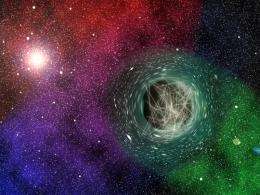Black holes as particle detectors

(�鶹��Ժ) -- Previously undiscovered particles could be detected as they accumulate around black holes say Scientists at the Vienna University of Technology.
Finding new particles usually requires high energies – that is why huge accelerators have been built, which can accelerate particles to almost the speed of light. But there are other creative ways of finding new particles: At the Vienna University of Technology, scientists presented a method to prove the existence of hypothetical “axions”. These axions could accumulate around a black hole and extract energy from it. This process could emit gravity waves, which could then be measured.
Axions are hypothetical particles with a very low mass. According to Einstein, mass is directly related to energy, and therefore very little energy is required to produce axions. “The existence of axions is not proven, but it is considered to be quite likely”, says Daniel Grumiller. Together with Gabriela Mocanu he calculated at the Vienna University of Technology (Institute for Theoretical �鶹��Ժics), how axions could be detected.
Astronomically Large Particles
In quantum physics, every particle is described as a wave. The wavelength corresponds to the particle’s energy. Heavy particles have small wavelengths, but the low-energy axions can have wavelengths of many kilometers. The results of Grumiller and Mocanu, based on works by Asmina Arvanitaki and Sergei Dubovsky (USA/Russia), show that axions can circle a black hole, similar to electrons circling the nucleus of an atom. Instead of the electromagnetic force, which ties the electrons and the nucleus together, it is the gravitational force which acts between the axions and the black hole.
The Boson-Cloud
However, there is a very important difference between electrons in an atom and axions around a black hole: Electrons are fermions – which means that two of them can never be in the same state. Axions on the other hand are bosons, many of them can occupy the same quantum state at the same time. They can create a “boson-cloud” surrounding the black hole. This cloud continuously sucks energy from the black hole and the number of axions in the cloud increases.
Sudden Collapse
Such a cloud is not necessarily stable. “Just like a loose pile of sand, which can suddenly slide, triggered by one single additional grain of sand, this boson cloud can suddenly collapse”, says Daniel Grumiller. The exciting thing about such a collapse is that this “bose-nova” could be measured. This event would make space and time vibrate and emit gravity waves. Detectors for gravity waves have already been developed, in 2016 they are expected to reach an accuracy at which gravity waves should be unambiguously detected. The new calculations in Vienna show that these gravity waves can not only provide us with new insights about astronomy, they can also tell us more about new kinds of particles.
More information:
Original publication:
free arxiv-version:
Additional information, written by Gabriela Mocanu:
Provided by Vienna University of Technology


















